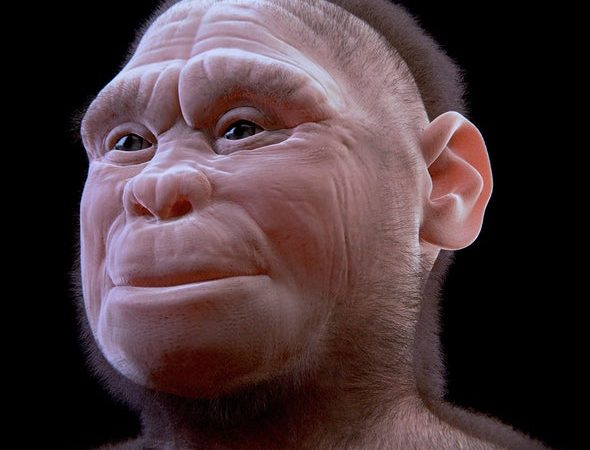A shocking discovery made a decade and a half ago is changing our understanding of human evolution
Source: Scientific America
A little more than 15 years ago, the world was introduced to a new, pint-sized member of the hominin family that shook the science of human origins. It was the discovery of a single, tiny skeleton named Homo floresiensis and nicknamed “the Hobbit.” There was no one thing that made the find shocking. Instead, detail after detail generated a perfect storm of commotion. First, there was the creature’s anatomy: standing at just over a meter tall, with a tiny, chimpanzee-size brain, the hobbit was surprisingly little. It also had an odd combination of features, a mixture of traits that usually appear solely in either ancient human ancestors or modern ones.
Then, there was the place of discovery. The volcanic, Indonesian island of Flores lies across a deepwater straight and is thus inhabited only by creatures able to make treacherous water crossings. The timeframe was perplexing as well: the hobbit was proposed to have existed only 18,000 years ago. This was a time when modern Homo sapiens were thought to have been left alone on the planet, the final upright-walking ape left standing. It was also a time when and were known to have been in the area.
The implications were staggering, challenging much of what scientists thought they knew about human evolution. Had small, somewhat primitive creatures lived in the recent past alongside modern humans, making complex water crossings and crafting stone tools? To explain the enigma, the discovery team first suggested H. floresiensis had evolved from Homo erectus, a slightly more primitive species known to have been living throughout Asia. Invoking a process known as insular dwarfism, whereby some large animals get smaller on islands, the team argued that the hobbit was a shrunken H. erectus.
Other, unsatisfied scientists quickly raised alternative hypotheses. One group argued it was merely a diseased modern human, pointing to the pathology “microcephaly” (small-headedness) to explain the hobbit’s diminutive nature. Scans of the braincase, however, revealed that the hobbit’s brain shared nothing in common with that of microcephalics.
With additional hobbit finds the following year, the team turned to a different hypothesis—one that appeared almost as fictional as a Tolkien tale. There was a close relationship, they argued, between H. floresiensis and a more distant group of ancestors. The team suggested the species resembled primitive three-million-year-old Australopithecines like the famous Lucy.
Drawing connections between hobbits and Australopithecines (or a closely related early Homo species) requires an enormous shift in perspective. It suggests that hominins left Africa in a very primitive form, travelling across the globe without leaving a trace. While this idea raised some issues, it potentially solved others. Australopiths were already small, for example—as were their brains. Thus, maybe the hobbit had never shrunk at all.
Debates churned, new pathology hypotheses emerging and repeatedly being knocked down. At one conference, a scientist wondered whether agreement could even be reached on if the sky was blue. Examinations of the hobbit’s skeleton from 2007–2009 began supporting a connection between the hobbit and an Australopithecine-like creature. Examinations of the wrist, for example, revealed it was extremely primitive. This poked holes in the dwarfed H. erectus argument because, now, a H. erectus connection would have had to invoke both shrinking and evolutionary reversals to more primitive traits.
But nothing was settled yet. The hobbit’s medley of characters persistently sent mixed signals; some features suggested a resemblance to Australopithswhile others indicated a likeness to H. erectus. Shackled by an imperfect fossil record and the realization that insular dwarfism is far from straightforward, difficulties remained. On the tenth anniversary of the announcement, paleoanthropologists continued to wonder about the hobbit’s story.
Between then and now, however, much has changed. The discovery team revised the hobbit timeline, arguing that the species disappeared closer to 50,000 years ago. A fossil jawbone and some teeth have also emerged from a different Flores site; this one is regarded as “Homo floresiensis–like.” While these more ancient fossils are too incomplete for draw firm conclusions, share the hobbits’ small size. A discovery in the Philippines recently revealed another small hominin with a different mosaic of traits—further signifying that human evolution was complex, especially on islands.
So, is the hobbit mystery solved? Far from it. Though the vast majority of researchers now agree that H. floresiensis was not a pathological human, questions remain regarding the hobbits’ evolution, arrival on the island and cognitive capacity. Over the last decade and a half, however, progress has been made; some hypotheses have eroded away as detailed inquiries emerged. It seems more likely than ever that the community will one day reach a consensus on the nature and origins of H. floresiensis.
More broadly, the hobbit has sparked transformations that are more pervasive and more difficult to measure than the bones themselves. Paleoanthropologists today are increasingly open to viewing the hominin story as one characterized by diversity, seeing the past as an entangled web of species. This hobbit-induced change has forced us to reconsider how humans fit within that story. We are no longer obvious, sole survivors of the evolutionary struggle, but perhaps simply a lucky branch on a complex tree.
Scientists have also grown increasingly comfortable with the idea of a past full of undiscovered hominins. As a paleoanthropologist suggested 15 years ago, the hobbit “shows how much we still have to learn.” Perhaps it is these larger shifts in outlook that will ultimately make up the legacy of H. floresiensis.
Source: Scientific America
































Leave a Comment
You must be logged in to post a comment.